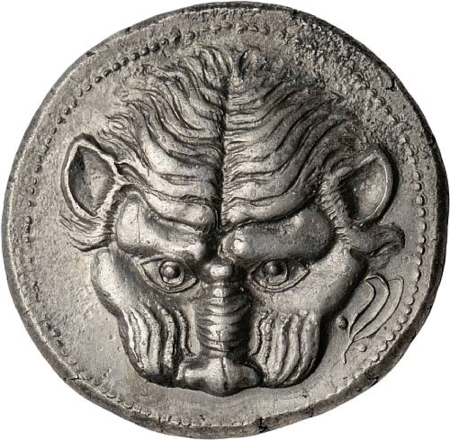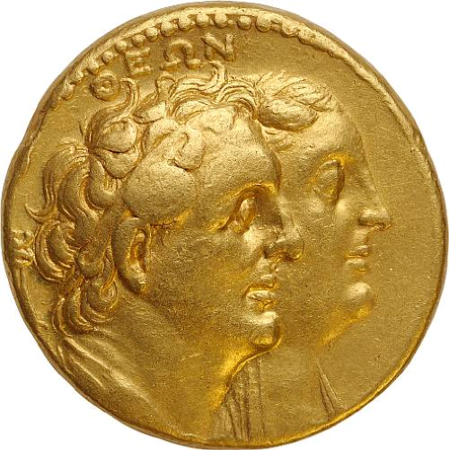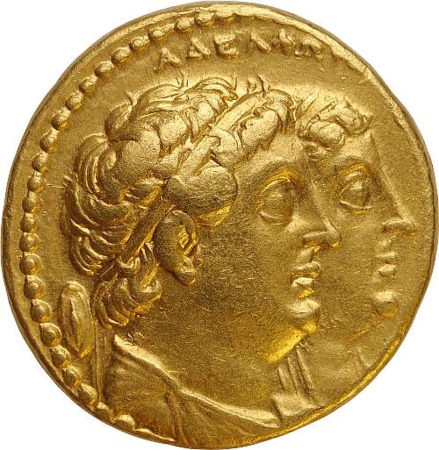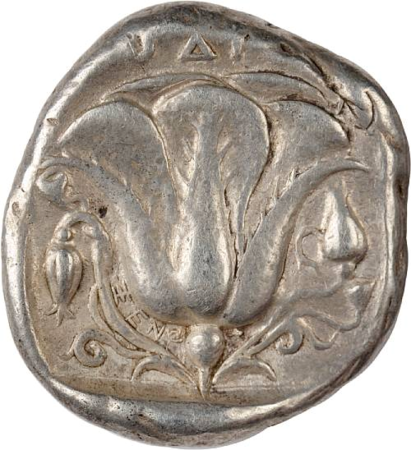Bonhams to sell the Meyer & Ebe Collection of ancient Greek coins on January 6
NEW YORK, N.Y.- Bonhams announces the sale of the Meyer & Ebe Collection of Ancient Greek Coins on January 6. This small, exquisite collection of coinage of classical antiquity will comprise just over 100 lots, with coins issued from the 6th century BC to the 1st century AD. Several classic design types will be represented in this unique auction from a number of the most famous parts of ancient Greece, including but not limited to Syracuse, Macedon, Athens, Rhodes, Bithynia, Cappadocia and Syria. Pre-sale estimates for this sale range from the very affordable $150-200, up to loftier prices such as $115,000-125,000.
Paul Song, Director of the Rare Coins and Banknotes Department at Bonhams, states, “Bonhams is delighted to have been entrusted with this lovely collection of Greek Coins from a private collector who has enjoyed searching for and purchasing these coins over the last decade. Different regions of Classical Greece and numerous design types are well represented throughout the collection, and with the recent strength of the ancient Greek coin marketplace, we anticipate a very strong sale.”
One important highlight of the Meyer & Ebe Collection is an exceedingly rare Mysia, Pergamum, Gold Stater ca. 336 BC (pre-sale estimate $115,000-125,000). 61g. Gulbenkian - 699, Jameson-2580 (Same Coin). Only three examples recorded. This historically highly significant coin was a piece presumably of Herakles, illegitimate son of Alexander, who grew up in Pergamon. It is very likely that he commissioned the emission before his assassination in 309.
Alexander III as Herakles, wearing lion skin, facing right. Reverse: Archaistic Palladion standing figure with chlamys over shoulder, spear in raised right hand, shield w/ star in left hand. Crested Corinthian helmet in lower left field. Struck in extremely high relief, a few microscopic handling marks are confined mostly to the reverse field which are a very minor issue when one considers the extreme rarity of this outstanding specimen.
The Kingdom of Pergamum, situated in modern-day Turkey approximately 85 kilometers north of Izmir and 25 kilometers east of the Aegean Sea, played a significant role in the Ancient Mediterranean stage. The ancient city of Pergamon (or Pergamum, today's Bergama) was created by the newly-founded royal dynasty in the mid-third century BCE. It became one of the classic late-Hellenistic cities, on a dramatically steep site, with imaginative solutions to the urban design problems created by the site, wonderfully embellished by the generous attention of its royal (and other) patrons. The site divides into two main sections, the steep upper town and the flat lower town. Though today's Bergama is entirely in the lower areas, a number of important remains have survived even there: the Asklepieion, one of the major healing centers of antiquity, the Red Hall (Serapeum), the stadium, a Roman Bridge and tunnel. But it is the upper town that captures the imagination, with its extensive remains, innovations, and drama.
Bruttium, Rhegium, Tetradrachm, 425-420 BC. Photo: Bonhams
Another beautiful coin is a Bruttium, Rhegium, Tetradrachm, 425-420 BC (pre-sale estimate $30,000-40,000). 17.31g. Herzfelder-59, HN Italy-2491. Obverse: Lion's head facing, two olive leaves with berries in right field. Reverse: City founder Iokastos seated left, holding staff and resting left hand on hip, snake below seat, city name PHΓΙMΟM, all within wreath. This is one of the last die combinations used in the lion's head/seated Iokastos series. The youthful Iokastos is a beautiful Greek sculpture reminiscent to the similar beautiful Tarsus on the early series of Tarentum, possibly by the same hand. The obverse of this coin is very sharp and although they are considered to be in low relief this is in relatively high relief. This is a wonderful piece of early classicalGreek art. Slight granulation under Iokastos' chair, otherwise a lightly toned example.
There are also numerous rarities from Ptolemaic Egypt, including a silver Decadrachm struck under Ptolemy III for the deified Arsinoe II, ca. 246-241 BC (pre-sale est. $25,000-28,000). 35.58g. Svoronos-961, pl. XXVIII, 25-6. Posthumous issue probably struck under Ptolemy III for the deified Arsinoe II. Obverse: Veiled head of deified Arsinoe right with ram's horn, in stephane, transverse scepter in background, B monogram behind. Reverse: ΑΡΣΙΝΟΗΣ-ΦΙΛΑΔΕΛΦΟΥ, filleted double cornucopia. Extremely beautiful dekadrachm with natural patina and complete absence of the normal heavy corrosion and extensive pitting and planchet breaks that these coins are routinely subjected to. A wonderful example. Ex Gemini I, 1/11/2005, #250.
and a gold Octodrachm of Ptolemy II struck in Alexandria, 3rd century BC (pre-sale est. $25,000-30,000). 27.61g. Unpublished. Obverse: ΘEΩN, jugate busts right of Ptolemy I, diademed and wearing aegis, and Berenike I, diademed and veiled, serpent staff left at border. Reverse: AΔEΛNΩ(N), jugate busts right of Ptolemy II, diademed and draped, and Arsinoe II, diademed and veiled, shield to left. Well centered and struck in bright yellow gold.
For the Egyptian priesthood, Hermes was the Greek equivalent of Thoth, the god of scribes and, by extension, the god of law. In Egyptian cosmology, it was the essential role of the pharaoh/king to uphold the cosmic order and prevent chaos by serving as the intermediary between gods and men. Earthly law was the same concept on a lower plane; it prevented society from descending into chaos. It's just possible, then, that the serpent staff behind the head of Ptolemy I represents an attempt to develop a visual symbol, in terms of Greek iconography, for the concept of order (Egyptian Ma'at). Ptolemy V was explicitly compared to Hermes "The Great and Great" in an inscription (OGIS I, 90, line 19). The inscription refers to the provision of justice (literally, "the just thing," which is not quite the same) for all. Huss says this is the only time this comparison was made in this reign.
It is almost unheard of to find something new on a large and well-known issue such as this, but this is in fact the case. The caduceus behind the head of Ptolemy I is totally unknown. If a new symbol were found on a coin of the Roman Republic it would mean nothing. In this case, it is very important.
The Ptolemaic kings of Egypt inherited vast wealth along with the kingdom of Egypt from Alexander the Great, who had conquered the country in 332 BC. Thanks to supplies of gold from Nubia within the kingdom itself, the Ptolemies were able to issue coinage in gold far more frequently than contemporary kings.
This issue was produced by the second Ptolemaic ruler, Ptolemy II Philadelphos (284-246 BC). He was given the epithet Philadelphos, which means 'sister (or brother)-loving' in Greek, due to his marriage, in Egyptian style, to his sister Arsinoe II.
The portraits on the obverse of this coin are of Ptolemy I Soter (305-282 BC) and his queen Berenike I, the legend above them reads 'Theoi' ('gods'), indicating that Ptolemy II had deified his parents. The portraits on the reverse are of Ptolemy II Philadelphos and his queen and sister, Arsinoe II, with the inscription 'Philadelphoi' ('brother- and sister-loving').
The whole design of this coin, through both its portraits and legends serves to reinforce the impression of dynastic harmony within the royal family of Egypt.
One of the most famous classical designs is exemplified by a silver Decadrachm from Sicily, Syracuse, 405-380 BC, by the famed Euainetos, with a four horse chariot on one side and the Nymph Arethusa on the other (pre-sale est. $20,000-25,000). 43.08g. Dewing-898, Galatin IX/DII. Signed die. Obverse struck with a rusty die but well centered. Extremely beautiful head of Arethusa with the delta (Δ) symbol below her chin. Because of the centering, the complete name of the city shows above the head of Arethusa but none of the master's signature is visible which is below Arethusa's neck. Only two reverse die varieties with the delta symbol are known.
Another true highlights is an exquisite silver Tetradrachm of Caria, Rhodes, 408-404 BC, signed by the artist IENO. The design includes a three-quarters facing sun god Helios on the obverse, and on the reverse, a rose representing the city-state of Rhodes. This coin is especially famous and beautifully rendered (pre-sale est. $18,000-22,000). 15.2g. Obverse: Head of Helios, 3/4 facing right in plain field, hair loose. Reverse: Rose with buds on either side, signed by IENO (ΞΕΝΟ) below left; (P)ΟΔΙ(ON) above. A highly unusual example with the bold signature.
Song also notes, “The coins of classical antiquity have been valued and collected for over 2500 years, and represent the pinnacle of die engraving and artistry. Bonhams is exceedingly pleased to continue this ancient and learned tradition.”
The Meyer & Ebe Collection of Ancient Greek Coins will be on display in the New York offices of Bonhams before the auction from January 4-6, 2012 and will nearly coincide with the annual New York International Coin Convention, the most important convention of Ancient and World Coins held in the United States

/https%3A%2F%2Fprofilepics.canalblog.com%2Fprofilepics%2F1%2F0%2F100183.jpg)
/https%3A%2F%2Fstorage.canalblog.com%2F03%2F02%2F119589%2F96711876_o.jpg)
/https%3A%2F%2Fstorage.canalblog.com%2F11%2F31%2F119589%2F94773502_o.jpg)
/https%3A%2F%2Fstorage.canalblog.com%2F20%2F83%2F119589%2F94772815_o.jpg)
/https%3A%2F%2Fstorage.canalblog.com%2F26%2F72%2F119589%2F75604929_o.jpg)
/https%3A%2F%2Fstorage.canalblog.com%2F59%2F60%2F119589%2F26458628_o.jpg)














/http%3A%2F%2Fstorage.canalblog.com%2F04%2F47%2F119589%2F92629189_o.jpg)
/http%3A%2F%2Fstorage.canalblog.com%2F27%2F00%2F119589%2F33503380_o.jpg)
/http%3A%2F%2Fstorage.canalblog.com%2F65%2F33%2F119589%2F92570161_o.jpg)
/http%3A%2F%2Fstorage.canalblog.com%2F42%2F72%2F119589%2F122383724_o.jpg)